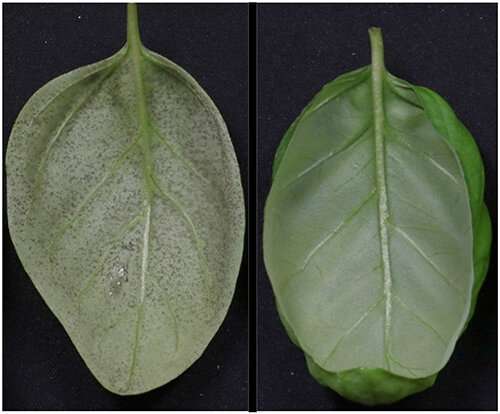Using environmental modifications, fungicides, and resistant varieties to fight basil downy mildew

The most widely grown of all the herbs, basil, is also highly susceptible to downy mildew, which spreads quickly through spores dispersed by wind and can wipe out an entire field or greenhouse. The disease was first spotted in Uganda in 1932; then it disappeared for nearly 70 years. Later, it was spotted again in Switzerland in 2001. Scientists still don’t understand why it reappeared, but they are working hard to learn more about the disease and develop effective management strategies.
“Currently an integrated management approach with multiple practices is recommended to achieve the very high level of downy mildew control,” explain Patel et al, authors of the recently published article on basil downy mildew management in Plant Health Progress Focus Issue.
First, after determining that spice types of basil were less susceptible to downy mildew than the more commonly grown sweet basil, breeders were able to start finding resistance genes to breed into basil, a process that can take many years. There are now several resistant basil varieties that are commercially available, but recent observations are finding that downy mildew is more severe than expected.
Fungicides are also an important part of downy mildew management. Research trials have shown that there are some fungicides that are suitable for downy mildew management. Scientists recommend that growers alternate fungicides and begin applying weekly before symptoms appear to minimize opportunity for the pathogen to develop resistance. Other downy mildew pathogens have shown they can evolve quickly to develop resistance to fungicides. Scientists suspect that this will also happen with basil downy mildew pathogen.
Additional and more cutting-edge control methods are also gaining traction, such as keeping leaves dry to prevent pathogen spores from germinating, turning on red or white lights at night to prevent germination, and dehumidifying the air.
Early protection, fungicide effectively reduce downy mildew in basil
Jaimin S. Patel et al, Effective Downy Mildew Management in Basil Using Resistant Varieties, Environment Modifications, and Fungicides, Plant Health Progress (2021). DOI: 10.1094/PHP-02-21-0041-FI
Provided by
American Phytopathological Society
Citation:
Using environmental modifications, fungicides, and resistant varieties to fight basil downy mildew (2021, November 4)
retrieved 4 November 2021
from https://phys.org/news/2021-11-environmental-modifications-fungicides-resistant-varieties.html
This document is subject to copyright. Apart from any fair dealing for the purpose of private study or research, no
part may be reproduced without the written permission. The content is provided for information purposes only.
For all the latest Science News Click Here
For the latest news and updates, follow us on Google News.

